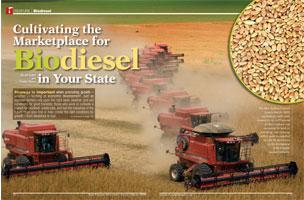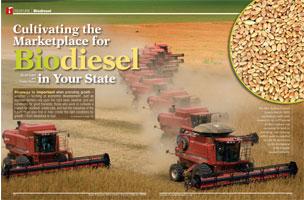

Strategy is important when promoting growth – whether in farming or economic development. Just as soybean farmers rely upon the right seed, weather, and soil conditions for good harvests, those who work to cultivate a market for biodiesel, create jobs, and fuel the industries of the future must also find or help create the right conditions for growth – from feedstock to fuel.
Because Ohio is one of the states with an aggressive program promoting biodiesel, it will be used as an example quite often throughout this article. Grow the Feedstock
In the United States, soy is the number one feedstock for biodiesel which has seen domestic growth in sales from 500,000 gallons in 1999 to 250 million gallons in 2006.
Soybeans are grown primarily in the Midwest, though there are about 25 soybean-producing states. The Ohio Soybean Council projects that by 2009, soy biodiesel could create demand for up to 83 percent of Ohio’s soybean crop increasing the need for processing, and replacing dollars spent on imported oil with the investment in the development of the domestic biodiesel industry.
Make the Fuel
Producing the fuel is at the crux of any economic development related to the biodiesel industry. Biodiesel is produced by reacting alcohol with vegetable oil through a chemical process known as transesterification. Only a small percentage of the oil extracted from soybeans is used for biodiesel; the majority is used for food applications.
Aiming for the highest standard in the quality of the product is crucial to the health of any industry. To be fuel-grade, biodiesel must meet strict industry specifications (ASTM D6751). When biodiesel meets ASTM D6751 and is legally registered with the Environmental Protection Agency, it is a legal motor fuel for sale and distribution.
Ohio has three producers of biodiesel –they are Peter Cremer – North America, PEC Biofuels, and American Ag Fuels. Their current combined capacity is near 50 million gallons. New facilities are proposed to bring another 200 million gallons of soy biodiesel into production.
Their largest biodiesel producer, Peter Cremer, was the first-ever BQ9000-certified producer and, since, has also become a BQ9000-certified marketer of biodiesel. BQ-9000 is a certification program established by the National Biodiesel Board in the year 2000 to ensure that processors and marketers with this accreditation produce and deliver to the highest standards for biodiesel quality and performance.
Additionally, the Ohio Soybean Council, in partnership with the Ohio Department of Agriculture, has created voluntary quality assurance measures that further assure the quality of biodiesel produced in the state.
Cultivating the Market
Incentivizing blending facilities is one key to cultivating the market for biodiesel. The Alternative Fuel Transportation grant program, administered by the Ohio Department of Development, awarded grants to two biodiesel blending facilities (and 12 alternative fuel retailers for alternative fuel pump conversions) in 2007. These grants were designed to assist in the commercialization of alternative fuels and to help farmers, retailers and consumers by addressing both the supply and demand barriers often associated with emerging industries. The strategic placement of the biodiesel blending locations has increased the availability of alternative fuels throughout Ohio and serves as a catalyst for future retail and wholesale growth.
Transport the Product
The finished biodiesel product must be delivered to customers. Biodiesel cannot be piped, so marketers need to find other ways to transport it. Ohio utilizes its comprehensive transportation and infrastructure network as an advantage for building a biofuel industry in the state. With over 5,000 miles of operating railroads, Ohio’s rail network is the fourth-largest in the nation. Ohio also has the nation’s fourth-largest interstate highway system.
Market the Product
There is a growing market for biodiesel as more and more fleets recognize the operating and environmental benefits of using this fuel. Among experts, biodiesel is known as a fuel with exceptional lubricity that helps to extend the life of an engine. It also serves as a solvent, cleaning the fuel system as it moves through.
Biodiesel also serves as a tool to reduce pollution. In recent years, a number of airports have switched their vehicles to biodiesel in order to reduce harmful emissions. Many metropolitan public transit systems throughout the nation have begun using biodiesel. They find a noticeable decrease in emissions under the same conditions, as compared to traditional diesel fuel. Furthermore, a number of school districts are using biodiesel. So far 21 districts in Ohio have received financial support from the Department of Development to change over to biodiesel fuel.
Obviously, a network of facilities is needed to sell this fuel. Here too, incentives can help. Ohio’s Alternative Fuel Transportation incentives encourage the expansion of retail and wholesale facilities, providing Ohioans the opportunity to purchase biodiesel at 50 retail stations and from 150 wholesale facilities.
Siting Biodiesel Facilities
Siting biodiesel facilities considers three primary factors. Transportation is first in importance – a large operation will need rail and an excellent highway system. Being within reasonably-close proximity to a supply network for the feedstock of soy oil is second, since greater distance adds costs. Finally, being close to your buyers’ markets is a close third, since again cost enters into the selling price. Like all things “green,” biodiesel is gaining popularity and cultural acceptance in a number of ways. A recent independent film entitled “Fuel” clearly pegs biodiesel as an important answer to the nation’s fuel crisis. The industry can and will capitalize on this groundswell of public interest.
Innovation for the Future
On the innovation front, algae are emerging as feasible feedstock for biodiesel fuel. The first commercial algae-to-biofuel facility has recently opened in Texas. Full commercial viability is still developing, but experts agree the potential is very real. Algae’s promise stems from a suite of properties that make it unique:
It reproduces very fast - 300 growing “seasons” per year.
It does not require lots of high-quality land.
It has relatively high oil content (between 30 percent and 50 percent).
It avoids the perceived food-versus-fuel problem.
Kevin Berner, CEO of Ohio-based Phycal, says that growing algae is not the challenge. “People grow [algae for oil] today. The only question is cost. That’s where the focus needs to be.” Berner believes that algae-derived oil can one day be available for between $1 and $2 per gallon, which would make it competitive with other feedstocks and petroleum.
Marysville-based Univenture is poised to be a leader in an algae-based bio-economy, beginning with algae used for fuel and then eventually expanding to include bio-polymers and other products. Univenture CEO Ross Youngs believes that algae can be viable as an extremely prolific source of both oil and feedstock, with the ability to feed virtually every aspect of the current petroleum, biodiesel and ethanol industries. In short – algae can do anything that petroleum, biodiesel or ethanol can do – as long as it’s the right type of algae. Finding the right types, or strains, is a major focus in the ongoing research.
Processes like directed evolution, high-throughput robotic screening, and metabolic engineering are the talk of the algae-to-fuel in-crowd. According to Berner, “Processes like high-throughput screening take advantage of algae’s natural variations. Once we understand what causes the natural variations that make algae fat [high in lipid content] or fast [in terms of reproduction], we can genetically engineer it to better fit our needs.”
According to recent research conducted at the University of Idaho, in cooperation with the U.S. Department of Agriculture (USDA), every unit of energy needed to produce biodiesel yields 3.5 units of energy – up from 3.2 units. The study was based on biodiesel made from soybean oil. Contributing to the increase are higher soybean yields, decreased herbicide use and less energy used for crushing soybeans.
Biodiesel’s Future
The future for biodiesel is bright green. Opportunities are sprouting up all around us, but only those states that till the soil will reap the benefits. It requires growing the crops, knowing how to extract the oils, providing incentives for blending with diesel, having the infrastructure to move the product, helping businesses promote and sell it, and keeping an eye out for the state-of-the-art research and development. Strategic investments in the biodiesel industry are crucial.
